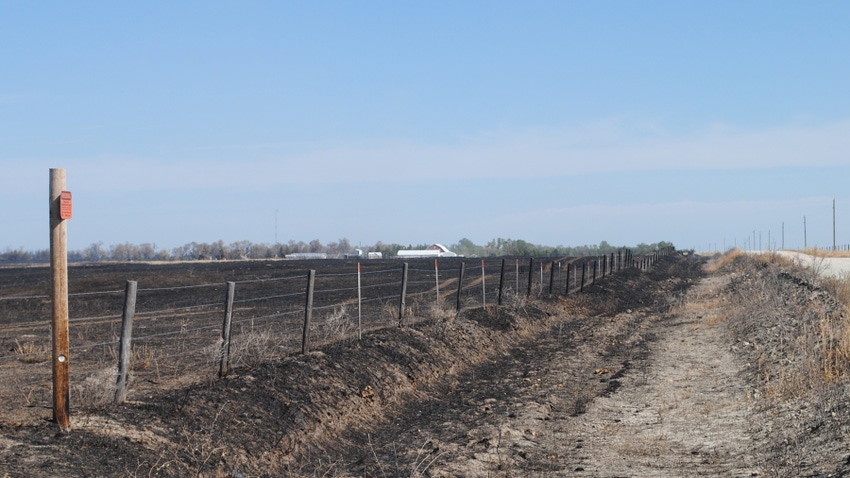
Wildfire season in Nebraska was ignited by what has become known as the Betty’s Way Fire north of North Platte on Feb. 26, scorching more than 71,000 acres of Lincoln and Custer counties over a two-day period.
But that wasn’t the only one. A grassfire broke out near Stapleton about the same time as everyone was watching the Betty’s Way Fire just to the south, and that fire burned about 7,000 acres. Fires were also reported between Grant and Imperial.
Fallout for ranchers
The result for producers is that there is no forage left on their scorched rangeland. “Most cattle need to be removed from pastures that were burned, as there is nothing to eat,” says Randy Saner, Nebraska Extension educator. “This means producers will need to feed more hay because they need to turn out later on burned pastures if we get enough rain. Some of the producers’ hay was burned up. In some cases, producers lost all their hay supply.”
With many ranchers starting to calve, and many losing calving sheds and holding pens, they will need to find additional portable panels to hold livestock, Saner adds.
“This summer, if we get rain, pastures can be grazed late, but all the fences are burned up, so they will have to be fenced,” he says. “[The Natural Resources Conservation Service] does have some programs where they will pay you to defer grazing, which means they would get money not to graze, but they will have to find pasture to rent, or confine those cows and feed hay and grain.”
Saner says that sometimes feedlots will have extra pens that can be leased for this purpose.
How it started
A disaster declaration came from Nebraska Gov. Jim Pillen on Feb. 26, along with an activation of the Nebraska Incident Management Team.
The Betty’s Way Fire started from a spark from a mowing operation, with a call coming into the North Platte 911 center around midmorning. With winds in excess of 40 mph, the fire rapidly spread.
It took 15 local volunteer fire departments to bring it under control the following day, according to Region 51 Emergency Management, which coordinates multijurisdictional responders in the event of disasters in Lincoln, Dundy and Hitchcock counties in central Nebraska.
Facebook posts on the Region 51 page began publishing Red Flag Warning posts several days before the fire, citing gusts up to 45 mph in the region, along with relative humidity readings as low as 14%.
In fact, one ironic post on that page at 10:20 a.m. Feb. 26 noted, “Any fires that start may spread rapidly and be difficult to control.”
Quick response
Region 51 reported in a news release that three fire stations responded to the initial call and were on the scene of the fire just over 8 miles north of North Platte in about 12 minutes. Nebraska National Guard and Nebraska State Patrol assisted with aerial and drone support, and the other volunteer fire departments dispatched after a call for mutual aid assistance.
The first Facebook post on the Region 51 page regarding the Betty’s Way Fire came at 12:03 p.m., asking residents along Rolling Hills Road north of North Platte and between Rolling Hills Road and North Maxwell Road to evacuate because of a large grassfire in the area.
By 12:45 p.m., Region 51 was asking residents 8 to 9 miles north of Brady to “turn on your pivots to help with the grassfire that is headed east at this time.”
By midafternoon, North Maxwell Road, North Brady Road and Highway 47 were all closed from Highway 30 north due to firefighting efforts, with the Brady Community Center opening for anyone who had to evacuate.
By 4 p.m. Feb. 27, Region 51 reported that the fire had been 72% contained, with hot spots still being dealt with over the following days. In true Nebraska weather whiplash fashion, a snow squall warning was issued for Lincoln County until 2:45 p.m. that same day, as crews were working to tamp out the remnants of the fire in a quick-moving snowstorm.
By March 1, the Betty’s Way Fire had been 98% contained. After the smoke had cleared, there were no injuries from the wildfire, but two primary residences and several outbuildings were burned, along with cattle losses and tens of thousands of acres of rangeland and crop ground.
Long-term impact
“Fires can help improve pasture, but these are usually from controlled burns,” Saner acknowledges. “Wildfires are a little different, but usually the grasses will come back more tender, and it would get rid of any red cedar trees that birds may have planted.”
Another negative impact from the fires is the loss of shelterbelts across the region, Saner says.
“The thing about the Sandhills is that we need to get back some of the litter that was burned off the ground, which can cause the sand to blow if the litter is not replaced,” he adds. “Rainfall can really help with that recovery.”
Here to help
Make donations to these funds that are part of community efforts in donating fencing, feed, windbreak materials, sheds, money and labor for those affected by the fire:
Miller Repair, Maxwell, at 308-582-4303
Maline Seed and Fence, Gothenburg, at 308-529-0781
Lincoln County Cattlemen at Equitable Bank, Box 728, North Platte, or call 308-532-7200
If you are a producer and need assistance, contact the following:
Lincoln County USDA Farm Service Agency and NRCS at 308-534-2360
Rural Response Hotline at 800-464-0258
UNL Lincoln-Logan-McPherson County Extension, North Platte, at 308-532-2683
UNL resources at beef.unl.edu/fire and at cropwatch.unl.edu.
About the Author(s)
You May Also Like






